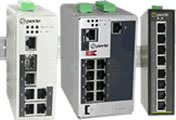Single Strand (WDM) Fiber
Connecting devices over single strand fiber
When Single Strand (also referred to as “Bi-Directional” BiDi or Simplex) fiber is used, a pair of devices, also referred to as “Up/Down” models, are needed for the fiber conversion.
A majority of installations for single mode or multimode fiber are of the “dual connector” or “dual fiber” type where one fiber connection is used for transmit, and the other is used for receive. These are physically “crossed” to match up the Transmit/Receive links.
However, to reduce costs, or where there are limits on available fiber, Wavelength-Division Multiplexing (WDM) technology may be utilized. WDM uses separate transmit and receive frequencies to communicate on a single fiber strand. WDM technology relies on the fact that optical fibers can carry many wavelengths of light simultaneously without interaction between each wavelength. Thus, a single fiber can carry many separate wavelength signals or channels simultaneously. WDM systems are divided into different wavelength patterns, conventional/coarse (CWDM) and dense (DWDM).

So remember, if Single Strand fiber is used, you will need an “Up” side and a “Down” side when interconnecting fiber devices.

